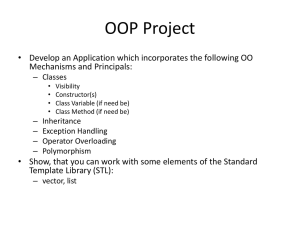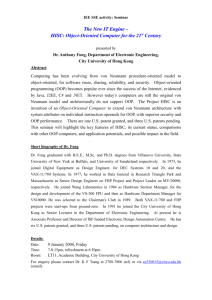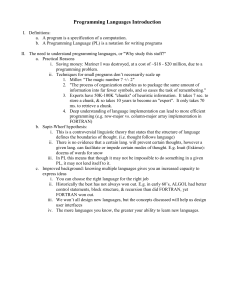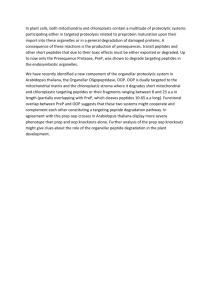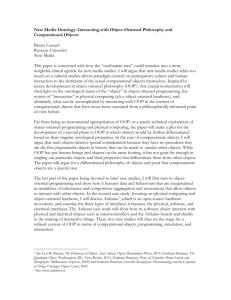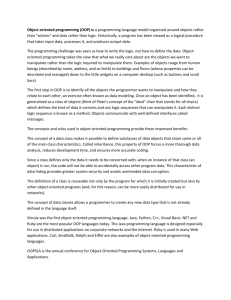Data protection as an integral part of OOP implementations
advertisement
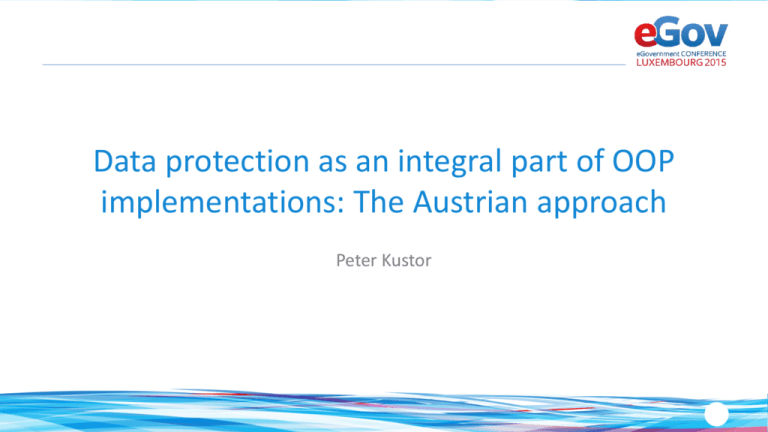
Data protection as an integral part of OOP implementations: The Austrian approach Peter Kustor OOP – What‘s behind? without OOP with OOP OOP – some benefits • Reduction of administrative burden • Cost reductions for the administration • Improved quality of service and of data • Improved administrative efficiency and effectiveness • Implementation supports one-stop/no-stop solutions • Improved mobility – if practised cross-border … OOP on the political agenda European Council Conclusions 24/25 Oct. 2013, Para 9: “[…] EU legislation should be designed to facilitate digital interaction between citizens and businesses and the public authorities. Efforts should be made to apply the principle that information is collected from citizens only once, in due respect of data protection rules.” OOP and data protection? „Main barriers“ „Measures to overcome these barriers“ Legal barriers: Data protection?! OOP: The Austrian Approach Conceptual Model Interconnected base registers serve as a common information base for different public bodies… Organisational aspects (1/2) Central coordination The Austrian Federal Chancellery coordinates the national implementation of the OOP Involvement of concerned parties Citizen‘s/businesses‘ consent is required for using data held within registers in the sense of the OOP – unless explicitly foreseen by law Back-office-approach Information provided by citizens/businesses once is (where this is lawful) shared within the public administration without requiring additional front-side-interaction [Front-office-approach electronically signed documents/ register extracts are widely available in AT and may also be used in procedures (where the back-office-approach is not used/preferred)] Organisational aspects (2/2) Decentralized architecture No central storage in „the one super-register“, but interconnected base registers as a common information base for implementation of the OOP Trigger for one-stop/no-stop-government strategy Information provided at a certain point can potentially initiate processes within different administrative areas (e.g. informing a public body about a name change) Legal Framework – Data Protection Law (1/2) § 1 (Constitutional Provision) - Fundamental Right to Data Protection § 6. (1) Data shall only 1. be used fairly and lawfully; 2. be collected for specific, explicit and legitimate purposes and not further processed in a way incompatible with those purposes; […] 3. be used insofar as they are essential for the purpose of the data application and are not excessive in relation to the purpose; 4. be used so that the results are factually correct with regard to the purpose of the application, and the data must be kept up to date when necessary; 5. be kept in a form which permits identification of data subjects as long as this is necessary for the purpose for which the data were collected; a longer period of storage may be laid down in specific laws, particularly laws concerning archives. Legal Framework – Data Protection Law (2/2) § 8. (1) […] no infringement […] if 1. an explicit legal authorisation or obligation to use the data exists; or 2. the data subject has given his consent, which can be revoked at any time, the revocation making any further use of the data illegal; or 3. vital interests of the data subject require the use; or 4. over-riding legitimate interests pursued by the controller or by a third party require the use of data. Legal Framework – E-Government Act § 17 (2) If: - preliminary question in a procedure - data contained in a public electronic register - data subject has consented to the acquisition of the data OR - that such acquisition through official channels is authorised by law Then: The authorities shall acquire the data themselves via electronic communications to the extent this is necessary - The authorities shall advise the data subject of the possibility of consenting - Data acquisition shall replace the presentation of proof of the data by the parties or persons involved. Technical concept – the „big picture“ Common eGovernment building blocks as a basis • essential component of Austria‘s national eGovernment strategy • common solutions for data exchange, identity management, authorization, etc. • field-tested and open source modules (via joinup.eu) Interconnected base registers • based on common Austrian eGovernment building blocks • operated by different public bodies • holding (person-related) data from different administrative sectors • data exchange based on common interfaces and specifications • security and data protection ‚by design‘ (data exchange powered by sector-specific identifiers (ssPIN)) • authentication & authorization at the back-office interaction powered by federation of portals-concept (PVP) Identity Management 1/3 – the aim • Unique identifiers based on core registers • Conformance with data protection - privacy friendly: Sector specific derivations (ssPIN) in electronic services/ applications • Reliable, high quality information ssPIN: Generation Source PIN irreversible derivation ssPIN a e.g. taxes & duties ssPIN b e.g. constructing & living Conversion impossible! If person-related data (lawfully) is transmitted across sectors, encrypted ssPINs have to be used thus avoiding the easy creation of comprehensive citizen profiles. Identity Management 2/3 – „provisioning“ Identity Management 3/3 – „Access“ Best Practices Implementation examples Best Practices - Providing proof of residence (1) without OOP Best Practices - Providing proof of residence (2) with OOP Best Practices - the Business Service Portal • One-stop-shop for businesses – the Business Service Portal (BSP) Initiative „Reducing Admin Burden for Businesses“ – Launched in 2006 – 230,000,000 times a year Austrian companies comply with information obligations to public authorities or a third person – 5,700 information obligations cause administrative burden of 4.3 billion Euro a year (1.6 % of GDP, measured in 2007) – target: reduce burden by 25 % or more than 1 billion Euro by 2012 Flagship-project: Austrian Business Service Portal (BSP) One-stop-shop for businesses Best Practices - the Business Service Portal Businesses must report the same or similar information to different authorities – The BSP provides a single distribution point for those information – BSP provides an electronic interface for automated data transmission from business software systems to public authorities – Eases fulfilment of reporting obligations – Heavily relies upon Austrian business register Best Practices – life-situation birth • Birth related administrative processes Aim: reducing administrative burden in the context of birth – Mainly achieved through automated triggering of specific procedures via the Austrian central register of civil status – Including inter-authority exchange of required information Examples for triggered/one-stop procedures – Report of the place of residence – Notification of social insurance – Issuance of proof of citizenship Initialization of family allowance → No-Stop-Procedure… Thank you! Peter.Kustor@bka.gv.at
